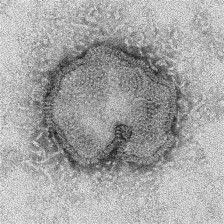H7N9 ‘one of most lethal’ influenza viruses—experts

This Monday, April 15, 2013 electron microscope image provided by the Centers for Disease Control and Prevention shows the H7N9 virus which can take on a variety of shapes. Almost three weeks after China reported finding a new strain of bird flu in humans, experts are still stumped by how people are becoming infected when many appear to have had no recent contact with live fowl and the virus isn’t supposed to pass from person to person. Understanding how the H7N9 bird flu virus is spreading is a goal of international and Chinese experts assembled by the World Health Organization as they begin a weeklong investigation Friday, April 18, 2013. AP FILE PHOTO
BEIJING — International experts probing China’s deadly H7N9 bird flu virus said Wednesday it was “one of the most lethal influenza viruses” seen so far and concluded that the likely source of infection was poultry.
China had confirmed 108 cases and 22 deaths since the first the infections were announced on March 31, with a higher proportion of cases in older people.
“This is definitely one of the most lethal influenza viruses we have seen so far,” said Keiji Fukuda, one of the leading flu experts for the World Health Organization, which has led a team on a week-long visit to China to study H7N9.
Fukuda told a news conference that the H7N9 virus is more easily transmissible than the more common H5N1 strain of bird flu. Experts had previously remarked on the “affinity” of H7N9 for humans.
“We think this virus is more transmissible to humans than H5N1,” he said, referring to the strain the WHO estimates has killed more than 360 people globally since 2003.
“When we look at influenza viruses this is an unusually dangerous virus,” he said, but he added: “We are really at the beginning of our understanding.”
The team said the likely source of infection was poultry, as chickens, ducks and pigeons from poultry markets had tested positive for H7N9, but nevertheless warned over the potential for human-to-human transmission.
“So far no migratory birds or their habitats have tested positive for H7N9,” said team member Nancy Cox, director of the influenza division at the US Centers for Disease Control and Prevention.
“At least we can now understand that the likely source of infection is poultry, the virus originates from poultry,” she said.
Experts have previously said the animal reservoir for H7N9 appeared to be unspecified birds.
There are worries over the prospect of such a virus mutating into a form easily transmissible between humans, which could then have the potential to trigger a pandemic.
But a statement released by the team, which includes Chinese experts, repeated that no human-to-human transmission has been discovered.
“No sustained person to person transmission has been found,” it said. “What remains unclear is whether the virus could gain the ability to become transmissible between people.”
A WHO official said last week that over 50 percent of those with the virus had remembered coming into contact with birds, raising questions over how the remaining cases became infected with H7N9.
Chinese health officials have acknowledged so-called “family clusters”, where members of a single family have become infected, but have so far declined to put it down to human-to-human transmission.
Such cases could be examples of what health officials call limited human-to-human transmission, in which those in close contact with the ill become infected, as opposed to widespread, or “sustained”, transmission.
So far most H7N9 cases have been confined to the commercial hub Shanghai and nearby provinces in eastern China.
But the number of reported new cases in Shanghai has seen a “dramatic slowdown”, Cox said, calling the reduction in the frequency of new cases “very encouraging.”
Tuesday marked the fourth consecutive day where no new cases were reported in Shanghai.














